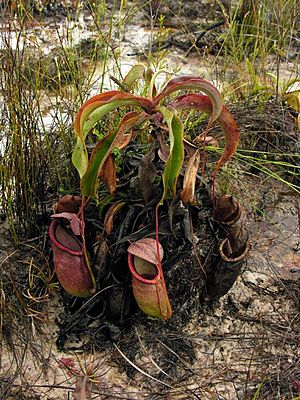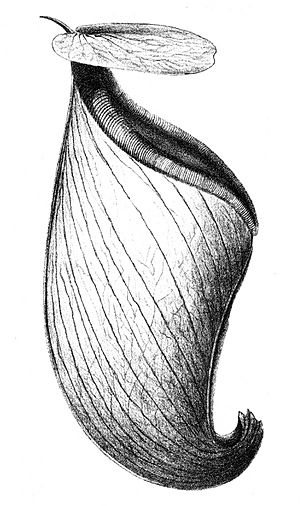Nepenthes rowaniae facts for kids
Quick facts for kids Nepenthes rowaniae |
|
|---|---|
 |
|
| A juvenile N. rowaniae plant | |
| Conservation status | |
| Scientific classification | |
| Genus: |
Nepenthes
|
| Species: |
rowaniae
|
| Synonyms | |
|
|
Nepenthes rowaniae is a special kind of pitcher plant found only in the Cape York Peninsula in Australia. It was named after Ellis Rowan, an Australian artist and nature lover. This plant is very similar to another pitcher plant called N. mirabilis. For a long time, scientists thought N. rowaniae was just a different version of N. mirabilis.
Contents
Understanding Nepenthes rowaniae
Pitcher plants are famous for their unique "pitchers," which are actually modified leaves. These pitchers act like traps for insects. Nepenthes rowaniae is one of these amazing carnivorous plants.
Between 1881 and 1905, a scientist named Frederick Manson Bailey described many Nepenthes plants from northern Australia. He thought they were all different species. However, in 1928, another scientist, B. H. Danser, looked at these plants again. He decided that most of them were actually the same as N. mirabilis.
Danser noted that N. rowaniae was a bit different. He saw that its upper pitchers had a unique bell-like shape. But he still thought this was just a small difference, not enough to make it a separate species.
However, more recent studies done between 2001 and 2003 showed that N. rowaniae is indeed its own species. Scientists found clear differences between N. mirabilis and N. rowaniae.
How N. mirabilis and N. rowaniae are Different
Here are some of the main ways these two pitcher plants are different:
| What to look at | N. mirabilis | N. rowaniae |
|---|---|---|
| Shape of leaf blade | Pointy or rounded | Gets narrower towards the end, then continues as a thin part along the tendril |
| How tendril joins leaf | Simple connection | Joins in the middle of the leaf (like a shield) |
| Pitcher wings | Simple, with small fringe parts | Often flat at the front, can look T-shaped when cut; also has fringe parts |
| Feel of leaf blade | Usually thin and paper-like | Very thick and leathery |
| How leaf joins stem | Simple, or rarely runs down the stem for a short bit | Runs down the stem for at least half its length, usually more |
| Glands inside pitcher (bottom) | 1600-2500 per square centimeter | About 3600 per square centimeter (many more!) |
| Where pitcher "hip" is (upper pitchers) | In the middle or lower half | In the top quarter |
| Where pitcher "hip" is (lower pitchers) | In the lower third or quarter | Right below the rim (peristome) |
Spelling the Name Correctly
The correct scientific spelling for this plant is Nepenthes rowaniae. This is because the name comes from a person's last name, Rowan. Even though you might sometimes see it spelled Nepenthes rowanae, the "ae" ending is the proper way to spell it in science.
Natural Hybrids
Sometimes, different species of plants can cross-breed naturally. This creates a "hybrid" plant that has features from both parents. Here are some natural hybrids involving N. rowaniae:
- N. mirabilis × N. rowaniae
- N. rowaniae × N. tenax



